key SKODA OCTAVIA TOUR 2009 1.G / (1U) Owner's Guide
[x] Cancel search | Manufacturer: SKODA, Model Year: 2009, Model line: OCTAVIA TOUR, Model: SKODA OCTAVIA TOUR 2009 1.G / (1U)Pages: 226, PDF Size: 13.11 MB
Page 64 of 226
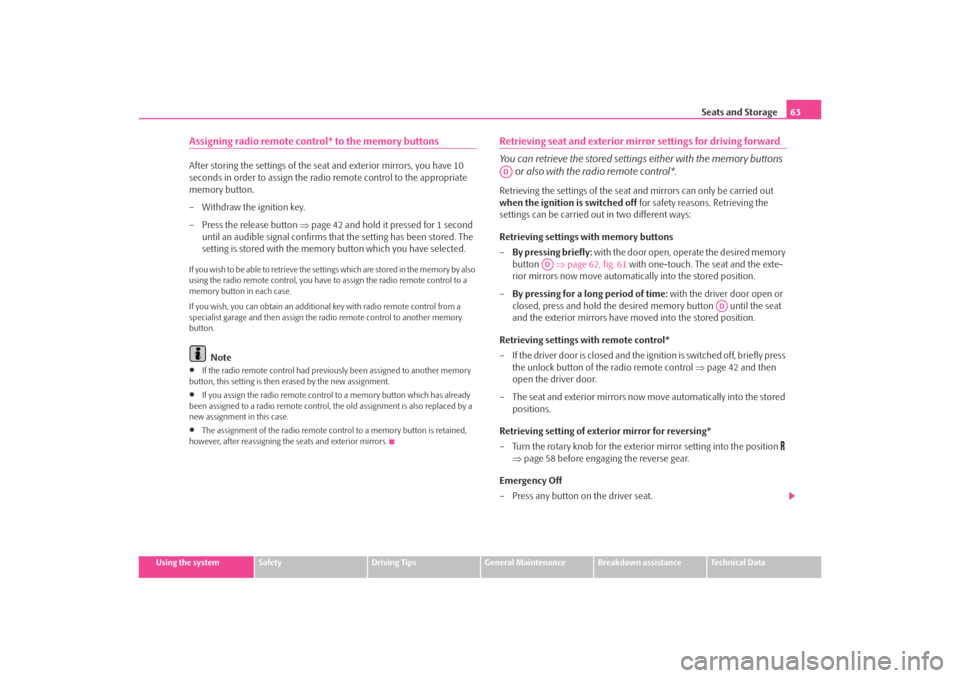
Seats and Storage63
Using the system
Safety
Driving Tips
General Maintenance
Breakdown assistance
Technical Data
Assigning radio remote control* to the memory buttonsAfter storing the settings of the seat and exterior mirrors, you have 10
seconds in order to assign the radio remote control to the appropriate
memory button.
– Withdraw the ignition key.
– Press the release button ⇒page 42 and hold it pressed for 1 second
until an audible signal confirms that the setting has been stored. The
setting is stored with the memory button which you have selected.If you wish to be able to retrieve the settings which are stored in the memory by also
using the radio remote control, you have to assign the radio remote control to a
memory button in each case.
If you wish, you can obtain an additional key with radio remote control from a
specialist garage and then assign the radio remote control to another memory
button.
Note
•
If the radio remote control had previous ly been assigned to another memory
button, this setting is then erased by the new assignment.
•
If you assign the radio remote control to a memory button which has already
been assigned to a radio remote control, the old assignment is also replaced by a
new assignment in this case.
•
The assignment of the radio remote control to a memory button is retained,
however, after reassigning the seats and exterior mirrors.
Retrieving seat and exterior mirror settings for driving forward
You can retrieve the stored settings either with the memory buttons or also with the radio remote control*.Retrieving the settings of the seat and mirrors can only be carried out
when the ignition is switched off for safety reasons. Retrieving the
settings can be carried out in two different ways:
Retrieving settings with memory buttons
– By pressing briefly: with the door open, operate the desired memory
button ⇒page 62, fig. 61 with one-touch. The seat and the exte-
rior mirrors now move automatically into the stored position.
– By pressing for a long period of time: with the driver door open or
closed, press and hold the desired memory button until the seat
and the exterior mirrors have moved into the stored position.
Retrieving settings with remote control*
– If the driver door is closed and the ignition is switched off, briefly press the unlock button of the radio remote control ⇒page 42 and then
open the driver door.
– The seat and exterior mirrors now move automatically into the stored
positions.
Retrieving setting of exterior mirror for reversing*
– Turn the rotary knob for the exterior mirror setting into the position
⇒ page 58 before engaging the reverse gear.
Emergency Off
– Press any button on the driver seat.
AD
AD
AD
s2ig.book Page 63 Monday, November 10, 2008 11:20 AM
Page 80 of 226
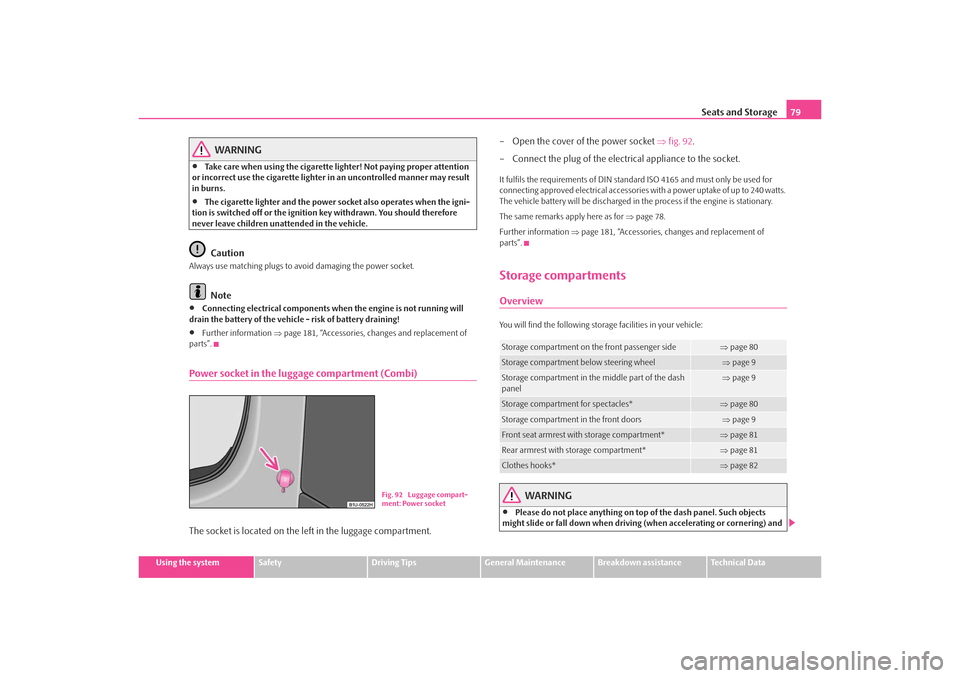
Seats and Storage79
Using the system
Safety
Driving Tips
General Maintenance
Breakdown assistance
Technical Data
WARNING
•
Take care when using the cigarette li ghter! Not paying proper attention
or incorrect use the cigarette lighter in an uncontrolled manner may result
in burns.
•
The cigarette lighter and the power so cket also operates when the igni-
tion is switched off or the ignition key withdrawn. You should therefore
never leave children unattended in the vehicle.Caution
Always use matching plugs to av oid damaging the power socket.
Note
•
Connecting electrical components when the engine is not running will
drain the battery of the vehicl e - risk of battery draining!
•
Further information ⇒page 181, “Accessories, chan ges and replacement of
parts”.
Power socket in the luggage compartment (Combi)The socket is located on the left in the luggage compartment. – Open the cover of the power socket
⇒fig. 92 .
– Connect the plug of the electrical appliance to the socket.
It fulfils the requirements of DIN standard ISO 4165 and must only be used for
connecting approved electrical accessories with a power uptake of up to 240 watts.
The vehicle battery will be discharged in the process if the engine is stationary.
The same remarks apply here as for ⇒page 78.
Further information ⇒page 181, “Accessories, changes and replacement of
parts”.Storage compartmentsOverviewYou will find the following storag e facilities in your vehicle:
WARNING
•
Please do not place anything on top of the dash panel. Such objects
might slide or fall down when driving (when accelerating or cornering) and
Fig. 92 Luggage compart-
ment: Power socket
Storage compartment on the front passenger side
⇒page 80
Storage compartment below steering wheel
⇒page 9
Storage compartment in the middle part of the dash
panel
⇒page 9
Storage compartment for spectacles*
⇒page 80
Storage compartment in the front doors
⇒page 9
Front seat armrest with storage compartment*
⇒page 81
Rear armrest with storage compartment*
⇒page 81
Clothes hooks*
⇒page 82
s2ig.book Page 79 Monday, November 10, 2008 11:20 AM
Page 81 of 226
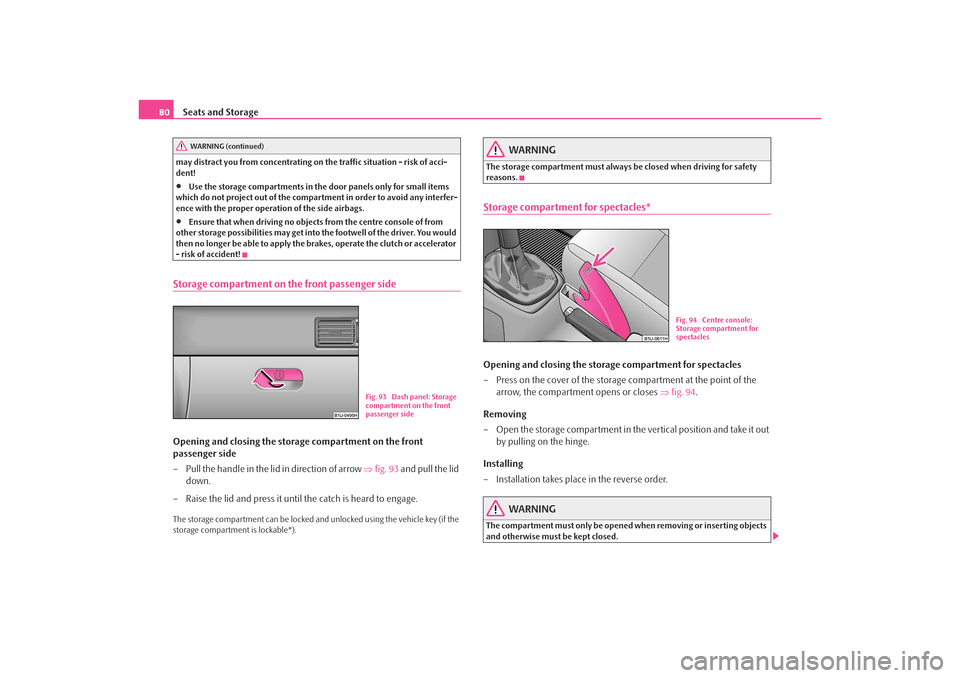
Seats and Storage
80may distract you from concentrating on the traffic situation - risk of acci-
dent!•
Use the storage compartments in the door panels only for small items
which do not project out of the compartment in order to avoid any interfer-
ence with the proper operation of the side airbags.
•
Ensure that when driving no objects from the centre console of from
other storage possibilities may get into the footwell of the driver. You would
then no longer be able to apply the br akes, operate the clutch or accelerator
- risk of accident!
Storage compartment on the front passenger sideOpening and closing the storage compartment on the front
passenger side
– Pull the handle in the li d in direction of arrow ⇒fig. 93 and pull the lid
down.
– Raise the lid and press it until the catch is heard to engage.The storage compartment can be locked and unlocked using the vehicle key (if the
storage compartment is lockable*).
WARNING
The storage compartment mu st always be closed when driving for safety
reasons.Storage compartment for spectacles*Opening and closing the storage compartment for spectacles
– Press on the cover of the storage compartment at the point of the arrow, the compartment opens or closes ⇒fig. 94 .
Removing
– Open the storage compartment in the vertical position and take it out by pulling on the hinge.
Installing
– Installation takes plac e in the reverse order.
WARNING
The compartment must only be opened when removing or inserting objects
and otherwise must be kept closed.
WARNING (continued)
Fig. 93 Dash panel: Storage
compartment on the front
passenger side
Fig. 94 Centre console:
Storage compartment for
spectacles
s2ig.book Page 80 Monday, November 10, 2008 11:20 AM
Page 96 of 226
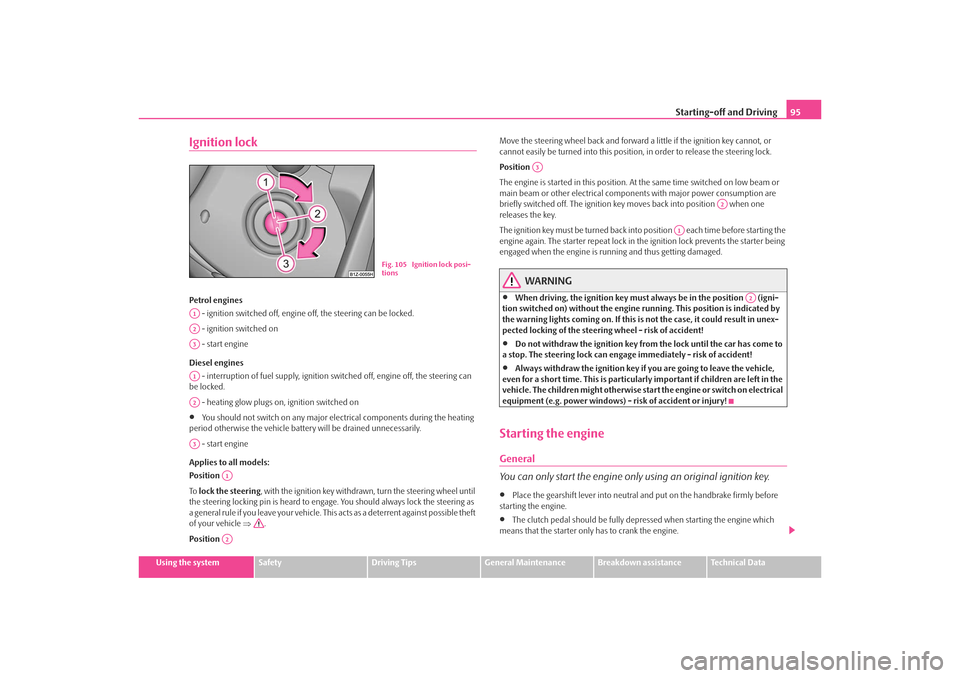
Starting-off and Driving95
Using the system
Safety
Driving Tips
General Maintenance
Breakdown assistance
Technical Data
Ignition lockPetrol engines
- ignition switched off, engine off, the steering can be locked.
- ignition switched on
- start engine
Diesel engines - interruption of fuel supply, ignition switched off, engine off, the steering can
be locked.
- heating glow plugs on, ignition switched on•
You should not switch on any major elec trical components during the heating
period otherwise the vehicle batter y will be drained unnecessarily.
- start engine
Applies to all models:
Position
To lock the steering , with the ignition key withdrawn, turn the steering wheel until
the steering locking pin is heard to engage. You should always lock the steering as
a general rule if you leave your vehicle. This acts as a deterrent against possible theft
of your vehicle ⇒.
Position Move the steering wheel back and forward a little if the ignition key cannot, or
cannot easily be turned into
this position, in order to release the steering lock.
Position
The engine is started in this position. At the same time switched on low beam or
main beam or other electrical compon ents with major power consumption are
briefly switched off. The ignition key moves back into position when one
releases the key.
The ignition key must be turned back into position each time before starting the
engine again. The starter repeat lock in th e ignition lock prevents the starter being
engaged when the engine is running and thus getting damaged.
WARNING
•
When driving, the ignition key must always be in the position (igni-
tion switched on) without the engine running. This position is indicated by
the warning lights coming on. If this is not the case, it could result in unex-
pected locking of the steering wheel - risk of accident!
•
Do not withdraw the ignition key from the lock until the car has come to
a stop. The steering lock can engage immediately - risk of accident!
•
Always withdraw the ignition key if you are going to leave the vehicle,
even for a short time. This is particularly important if children are left in the
vehicle. The children might otherwise star t the engine or switch on electrical
equipment (e.g. power windows) - risk of accident or injury!
Starting the engineGeneral
You can only start the engine only using an original ignition key.•
Place the gearshift lever into neutral and put on the handbrake firmly before
starting the engine.
•
The clutch pedal should be fully depressed when starting the engine which
means that the starter only has to crank the engine.
Fig. 105 Ignition lock posi-
tions
A1A2A3A1A2A3
A1A2
A3
A2
A1
A2
s2ig.book Page 95 Monday, November 10, 2008 11:20 AM
Page 97 of 226

Starting-off and Driving
96•
Let go of the key as soon as the engine starts otherwise there may be damage
to the starter.
The engine running noises ma y louder at first be louder for a short time after
starting the cold engine until oil pressure can be built up in the hydraulic valve
clearance compensation. This is quite no rmal and is not an operating problem.
If the engine does not start ...
You can use the battery of anothe r vehicle as a jump-start aid ⇒page 190.
It is only possible to tow-start vehicles fitted with a manual gearbox. The tow-
starting distance must not be more than 50 metres ⇒page 193.
WARNING
•
Never run the engine in non ventilat ed or enclosed areas. The exhaust
gases of the engine contain besides the odorless and colourless carbon
monoxide a poisonous gas - hazard! Carbon monoxide can cause uncon-
sciousness and death.
•
Never leave your vehicle unattended with the engine running.Caution
•
The starter may only be operated (ignition key position ), if the engine is not
running. If the starter is immediately operated after switching off the engine, the
starter or the engine can be damaged.
•
Avoid high engine revolutions, full throttl e and high engine loads as long as the
engine has not yet reached its normal oper ating temperature - risk of damaging the
engine!
•
Vehicles which are fitted with an exhaust gas catalyti c converter should not be
tow-started over a distance of more than 50 metres.For the sake of the environment
Never warm up the engine when the vehi cle is standing. Drive off right away.
Through this the engine reaches its operating temperature more rapidly and the
pollutant emissions are lower.
Petrol enginesThese engines are fitted with a starter system which selects the correct fuel/air
mixture for every external air temperature.•
Do not depress accelerator before and when starting engine.
•
Interrupt the attempt at starting after 10 seconds if the engine does not start
right awayand wait for about 30 seconds before repeating the attempt.
•
It is possible that the fuse on the electrical fuel pump is defect if the engine still
does not start. Check the fuse and replace it if necessary ⇒page 194.
•
Contact the nearest specialist garage to obtain professional assistance.
It may be necessary, if the engine is very hot, to slightly depress the accelerator
after the engine has started.
Diesel enginesGlow plug system
Diesel engines are equipped with a glow plug system, the preglow period being
controlled automatically in line with the coolant temperature and outside temper-
ature.
The preglow indicator light
comes on after the igniti on has been switched on.
You should not switch on any major electrical components during the heating
period otherwise the vehicle battery will be drained unnecessarily.
•
You should start the engine immediately after the glow plug warning light
has gone out.
•
The glow plug warning light will come on for about one second if the engine is
at a normal operating temperature or if the outside temperature is above +5°C.
This means that you can start the engine right away.
•
Interrupt the attempt at starting after 10 seconds if the engine does not start
right awayand wait for about 30 seconds before repeating the attempt.
•
It is possible that the fuse on the dies el preglow system is defect if the engine
still does not start. Check the fuse and replace it if necessary ⇒page 194.
•
Contact the nearest specialist garage to obtain professional assistance.
A3
s2ig.book Page 96 Monday, November 10, 2008 11:20 AM
Page 98 of 226

Starting-off and Driving97
Using the system
Safety
Driving Tips
General Maintenance
Breakdown assistance
Technical Data
Starting the engine after the fuel tank has run dry
It may take longer than normal to start the
engine after refuelling if the fuel tank has
run completely dry - up to one minute. This is because the fuel system must first of
all be filled while the attempting to start the engine.
Switching off the engine– The engine can be switched off by turning the ignition key from posi- tion into ⇒page 95, fig. 105 .
WARNING
•
Never switch off the engine before the vehicle is stationary - risk of acci-
dent!
•
The brake booster only operates when the engine is running. Greater
physical effort for braking is required when engine is switched off. Because
if you do not stop as normal, this can cause an accident and severe injuries.Caution
you should not switch the engine off right away at the end of your journey after the
engine has been operated for a lengthy period at high loads but should be allowed
it to run at idling speed for about 2 minutes . This prevents any accumulation of heat
when the engine is switched off.
Note
•
The radiator fan may continue running fo r a further 10 minutes or so after the
engine and the ignition have been switched off. The coolant fan may, however, also
switch on again after some time if the coolant temperature rises because of an
accumulation of heat in the engine or if the engine is warm and the engine
compartment is additionally heated by strong sunlight.
•
This is why particular care is required when carrying out any work in the engine
compartment ⇒page 162, “Working in the engine compartment”.
ShiftingShift into reverse only when the car is stationary. Depress the clutch pedal and hold
it fully depressed. Wait a moment before engaging reverse gear in order to avoid
any shift noises.
The reversing lights will come on once re verse gear is engaged, provided the igni-
tion is on.
WARNING
Never engage the reverse gear when driving - risk of accident!
Note
•
One should not lay the hand on the shift lever while driving the vehicle. The
pressure of the hand will be transferred to the gearshift forks in the gearbox. This
can, over a period of time, lead to early wear of the gearshift forks.
•
Depress the clutch pedal fully when changing gears, in order to avoid unneces-
sary wear and damage.
A1
Fig. 106 Shift pattern on
models fitted with 5-speed
manual gearbox
s2ig.book Page 97 Monday, November 10, 2008 11:20 AM
Page 104 of 226
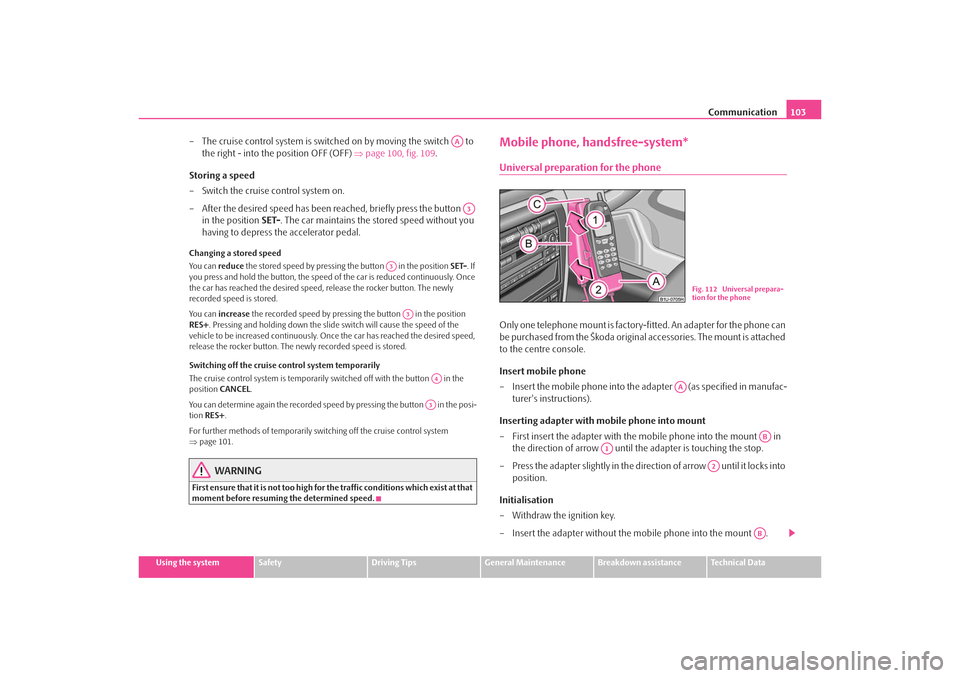
Communication103
Using the system
Safety
Driving Tips
General Maintenance
Breakdown assistance
Technical Data
– The cruise control system is switch ed on by moving the switch to
the right - into the position OFF (OFF) ⇒page 100, fig. 109 .
Storing a speed
– Switch the cruise control system on.
– After the desired speed has been reached, briefly press the button in the position SET-. The car maintains the stored speed without you
having to depress the accelerator pedal.Changing a stored speed
Yo u c a n reduce the stored speed by pressing the button in the position SET-. If
you press and hold the button, the speed of the car is reduced continuously. Once
the car has reached the desired speed, release the rocker button. The newly
recorded speed is stored.
Yo u c a n increase the recorded speed by pressing the button in the position
RES+ . Pressing and holding down the slide switch will cause the speed of the
vehicle to be increased continuously. Once the car has reached the desired speed,
release the rocker button. The newly recorded speed is stored.
Switching off the cruise control system temporarily
The cruise control system is temporarily switched off with the button in the
position CANCEL .
You can determine again the recorded speed by pressing the button in the posi-
tion RES+ .
For further methods of temporarily switching off the cruise control system
⇒ page 101.
WARNING
First ensure that it is not too high for the traffic conditions which exist at that
moment before resuming the determined speed.
Mobile phone, handsfree-system*Universal preparation for the phoneOnly one telephone mount is factory- fitted. An adapter for the phone can
be purchased from the Škoda original accessories. The mount is attached
to the centre console.
Insert mobile phone
– Insert the mobile phone into the adapter (as specified in manufac- turer's instructions).
Inserting adapter with mobile phone into mount
– First insert the adapter with the mobile phone into the mount in the direction of arrow until th e adapter is touching the stop.
– Press the adapter slightly in the direction of arrow until it locks into position.
Initialisation
– Withdraw the ignition key.
– Insert the adapter without the mobile phone into the mount .
AAA3
A3
A3
A4A3
Fig. 112 Universal prepara-
tion for the phone
AA
AB
A1
A2
AB
s2ig.book Page 103 Monday, November 10, 2008 11:20 AM
Page 105 of 226
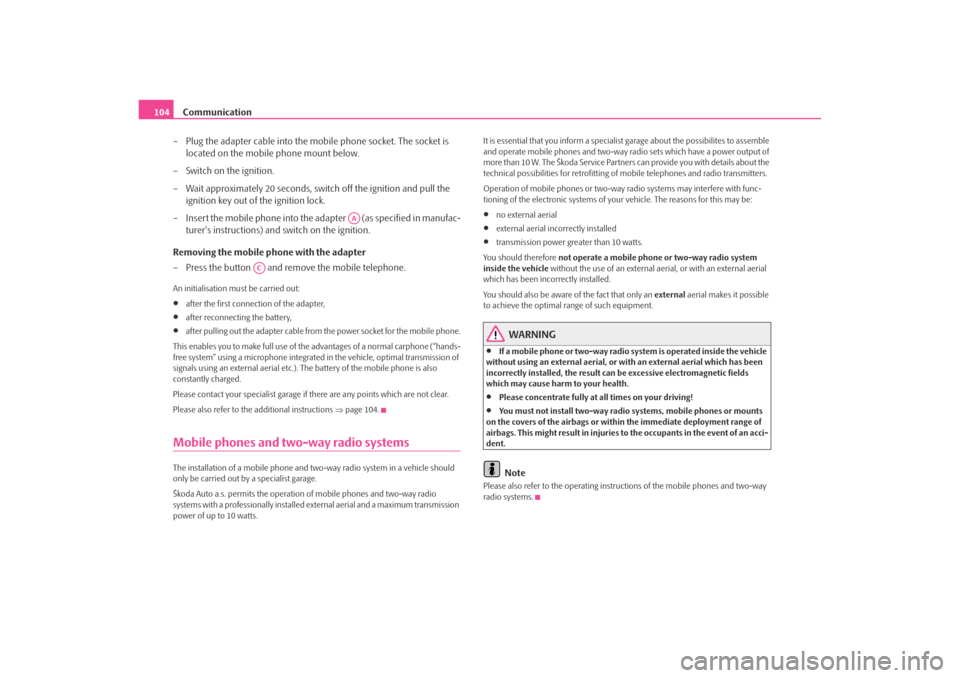
Communication
104
– Plug the adapter cable into the mobile phone socket. The socket is located on the mobile phone mount below.
– Switch on the ignition.
– Wait approximately 20 seconds, switch off the ignition and pull the ignition key out of the ignition lock.
– Insert the mobile phone into the adapter (as specified in manufac- turer's instructions) and switch on the ignition.
Removing the mobile phone with the adapter
– Press the button and remove the mobile telephone.An initialisation mu st be carried out:•
after the first connection of the adapter,
•
after reconnecting the battery,
•
after pulling out the adapter cable from the power socket for the mobile phone.
This enables you to make full use of the ad vantages of a normal carphone (“hands-
free system” using a microphone integrated in the vehicle, optimal transmission of
signals using an external aerial etc.). The battery of the mobile phone is also
constantly charged.
Please contact your specialist garage if there are any points which are not clear.
Please also refer to the additional instructions ⇒page 104.
Mobile phones and two-way radio systemsThe installation of a mobile phone and two-way radio system in a vehicle should
only be carried out by a specialist garage.
Škoda Auto a.s. permits the operation of mobile phones and two-way radio
systems with a professionally installed ex ternal aerial and a maximum transmission
power of up to 10 watts. It is essential that you inform a specialist
garage about the possibilites to assemble
and operate mobile phones and two-way ra dio sets which have a power output of
more than 10 W. The Škoda Service Partners can provide you with details about the
technical possibilities for retrofitting of mobile telephones and radio transmitters.
Operation of mobile phones or two-way radio systems may interfere with func-
tioning of the electronic systems of your vehicle. The reasons for this may be:
•
no external aerial
•
external aerial incorrectly installed
•
transmission power greater than 10 watts.
You should therefore not operate a mobile phone or two-way radio system
inside the vehicle without the use of an external aerial, or with an external aerial
which has been incorrectly installed.
You should also be aware of the fact that only an external aerial makes it possible
to achieve the optimal range of such equipment.
WARNING
•
If a mobile phone or two-way radio sy stem is operated inside the vehicle
without using an external aerial, or wi th an external aerial which has been
incorrectly installed, the result can be excessive electromagnetic fields
which may cause harm to your health.
•
Please concentrate fully at all times on your driving!
•
You must not install two-way radio systems, mobile phones or mounts
on the covers of the airbags or within the immediate deployment range of
airbags. This might result in injuries to the occupants in th e event of an acci-
dent.Note
Please also refer to the operating instru ctions of the mobile phones and two-way
radio systems.
AA
AC
s2ig.book Page 104 Monday, November 10, 2008 11:20 AM
Page 113 of 226

Seat belts
112•
No two persons (also not children) should ever use a single seat belt
together.
•
The maximum protection which seat belts can offer is only achieved if
you are correctly seated ⇒page 106, “Correct seated position”.
•
The belt webbing must no t run across solid or fragile objects (e.g. spec-
tacles, ball-point pens, keys etc.) as this may be a cause of injuries.
•
Bulky, loose clothing (e.g. a winter coat over a jacket) does not allow you
to be correctly seated and impairs proper operation of the seat belts.
•
It is prohibited to use clamps or other objects to adjust seat belts (e.g. for
shortening the belts for smaller persons).
•
The lock tongue should only be insert ed into the lock which is the correct
one for your seat. Wrong use of the safety belt will reduce its capacity to
protect and the risk of injury increases.
•
The backrests of the front seats must not be tilted too far to the rear
otherwise the seatbelts can lose their effectiveness.
•
The belt webbing must always be ke pt clean. Soiled belt webbing may
impair proper operation of the inertia reel ⇒page 155, “Seat belts”.
•
The slot of the belt tongue must not be blocked by paper or similar
objects otherwise the belt tongue will not lock in place properly.
•
Inspect the seat belts regularly to ensure they are in good condition. If
you find seat belts which have damage to the seat belt webbing, seat belt
connections, to the inertia reels or to the lock, the relevant safety belt must
be replaced by a specialist garage.
•
The seat belts must not be removed or changed in any way. Do not make
an attempt to repair the seat belts yourself.
•
Damaged seat belts which have been subjected to stress in an accident
and were therefore stretched, must be replaced - this is best done by a
specialist garage. The anchorage points of the belts must also be inspected.
The anchorage points for the be lts should also be checked.
•
In certain countries it is possible to use seat belts which differ in terms of
their operation from the seat belts which are described on the pages which
follow.
How are seat belts correctly fastened?Fastening three-point seat belts
Fasten your seat belt before starting!– Correctly adjust the front seat and the head restraint before fastening
your seat belt ⇒page 60.
WARNING (continued)
Fig. 118 Routing of webbing
over the shoulders and the
lap beltFig. 119 Routing of belt
webbing for an expectant
mother
s2ig.book Page 112 Monday, November 10, 2008 11:20 AM
Page 124 of 226
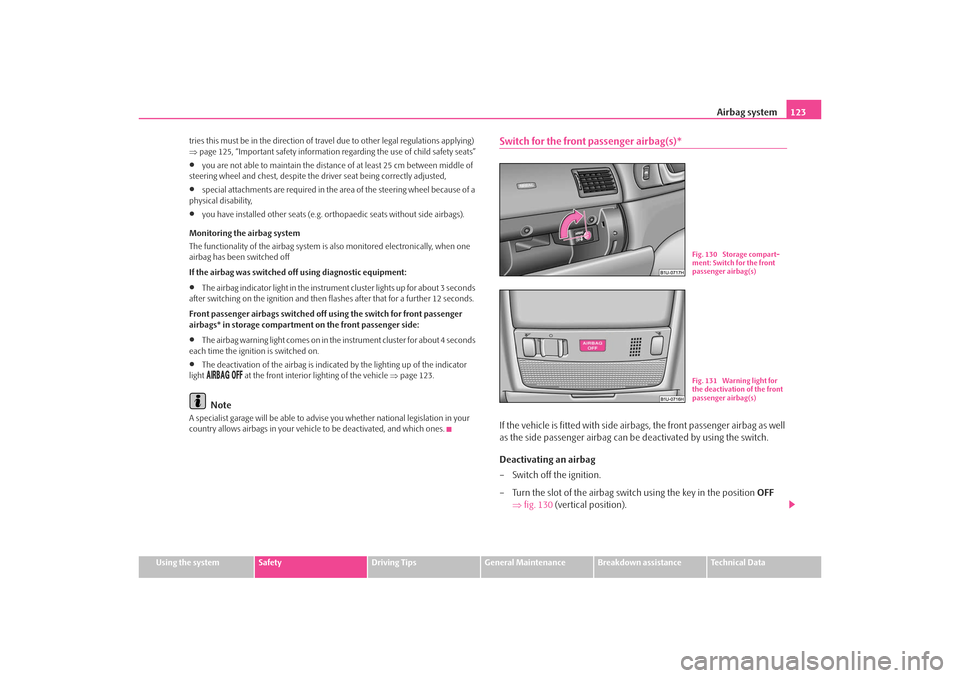
Airbag system123
Using the system
Safety
Driving Tips
General Maintenance
Breakdown assistance
Technical Data
tries this must be in the direction of travel due to other legal regulations applying)
⇒
page 125, “Important safety information regarding the use of child safety seats”
•
you are not able to maintain the distance of at least 25 cm between middle of
steering wheel and chest, despite the driver seat being correctly adjusted,
•
special attachments are required in the area of the steering wheel because of a
physical disability,
•
you have installed other seats (e.g. orthopaedic seats without side airbags).
Monitoring the airbag system
The functionality of the airbag system is also monitored electronically, when one
airbag has been switched off
If the airbag was switched of f using diagnostic equipment:
•
The airbag indicator light in the instrume nt cluster lights up for about 3 seconds
after switching on the ignition and then flashes after that for a further 12 seconds.
Front passenger airbags switched off using the switch for front passenger
airbags* in storage compartmen t on the front passenger side:
•
The airbag warning light comes on in the instrument cluster for about 4 seconds
each time the ignition is switched on.
•
The deactivation of the airbag is indica ted by the lighting up of the indicator
light
at the front interior lighting of the vehicle ⇒page 123.
Note
A specialist garage will be able to advise you whether national legislation in your
country allows airbags in your vehicl e to be deactivated, and which ones.
Switch for the front passenger airbag(s)*If the vehicle is fitted with side airbags, the front passenger airbag as well
as the side passenger airbag can be deactivated by using the switch.
Deactivating an airbag
– Switch off the ignition.
– Turn the slot of the airbag switch using the key in the position OFF
⇒ fig. 130 (vertical position).
Fig. 130 Storage compart-
ment: Switch for the front
passenger airbag(s)Fig. 131 Warning light for
the deactivation of the front
passenger airbag(s)
s2ig.book Page 123 Monday, November 10, 2008 11:20 AM